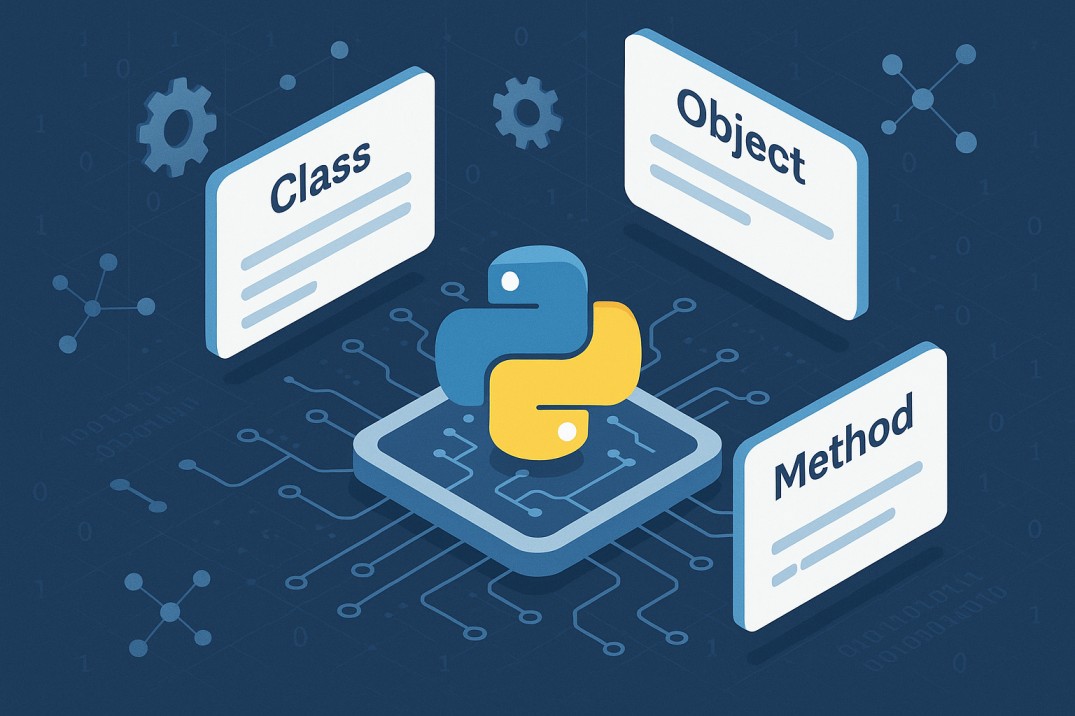Object-Oriented Programming (OOP) is a programming paradigm that organizes code around “objects” rather than functions and logic. By modeling real-world entities as objects with properties (data) and behaviors (methods), OOP promotes modularity, reusability, and maintainability. Python, a versatile language known for its simplicity, fully supports OOP principles. In this guide, we’ll explore OOP fundamentals in Python, including classes, inheritance, encapsulation, polymorphism, and best practices.
Introduction to OOP in Python
What is OOP?
OOP is a design philosophy that structures programs by bundling related data (attributes) and actions (methods) into objects. These objects interact to solve complex problems, mirroring how entities operate in the real world. For example, a Car object might have attributes like color and methods like drive().
Why Use OOP in Python?
- Modularity: Break down code into reusable components (classes).
- Abstraction: Hide complex implementation details.
- Encapsulation: Protect data from unintended modification.
- Inheritance: Share functionality between classes.
- Polymorphism: Use a single interface for different data types.
Python’s syntax and dynamic typing make OOP intuitive, whether you’re building small scripts or large-scale applications.
Core Concepts of OOP
Classes and Objects
- A class is a blueprint for creating objects. It defines attributes and methods.
- An object is an instance of a class. For example, a
Toyotacar is an instance of theCarclass.
Example: Creating a Class
class Dog:
def __init__(self, name, age):
self.name = name # Instance attribute
self.age = age
def bark(self): # Method
print(f"{self.name} says woof!")
# Create an object
my_dog = Dog("Buddy", 3)
my_dog.bark() # Output: Buddy says woof!
The Four Pillars of OOP
1. Encapsulation
Encapsulation restricts direct access to an object’s data, exposing only controlled interfaces. In Python, this is achieved using naming conventions:
_protected_var: A hint that a variable is “protected” (not enforced).__private_var: Name mangling makes it harder to access outside the class.
Example: Encapsulation with Getters/Setters
class BankAccount:
def __init__(self, balance):
self.__balance = balance # Private variable
# Getter
@property
def balance(self):
return self.__balance
# Setter
@balance.setter
def balance(self, value):
if value >= 0:
self.__balance = value
else:
raise ValueError("Balance cannot be negative.")
account = BankAccount(100)
account.balance = 200 # Uses setter
print(account.balance) # Output: 200
2. Abstraction
Abstraction hides internal complexity and exposes only essential features. Abstract Base Classes (ABCs) enforce method definitions in subclasses.
Example: Abstraction with ABCs
from abc import ABC, abstractmethod
class Shape(ABC):
@abstractmethod
def area(self):
pass
class Circle(Shape):
def __init__(self, radius):
self.radius = radius
def area(self):
return 3.14 * self.radius ** 2
# shape = Shape() # Error: Can't instantiate abstract class
circle = Circle(5)
print(circle.area()) # Output: 78.5
3. Inheritance
Inheritance allows a class (child) to inherit attributes and methods from another class (parent). This promotes code reuse.
Example: Inheritance Hierarchy
class Vehicle:
def __init__(self, brand):
self.brand = brand
def drive(self):
print("Driving...")
class Car(Vehicle):
def __init__(self, brand, model):
super().__init__(brand)
self.model = model
def drive(self): # Method overriding
print(f"{self.brand} {self.model} is speeding up!")
car = Car("Tesla", "Model S")
car.drive() # Output: Tesla Model S is speeding up!
4. Polymorphism
Polymorphism lets objects of different classes be treated as objects of a common superclass. Python achieves this through duck typing and method overriding.
Example: Duck Typing
class Cat:
def speak(self):
print("Meow!")
class Duck:
def speak(self):
print("Quack!")
def animal_sound(animal):
animal.speak()
cat = Cat()
duck = Duck()
animal_sound(cat) # Output: Meow!
animal_sound(duck) # Output: Quack!
Implementing OOP in Python
Class Methods and Static Methods
Static methods: Use @staticmethod for utility functions unrelated to instances.
Instance methods: Require self and operate on instance data.
Class methods: Use @classmethod and cls to modify class-level attributes.
Example:
class Pizza:
base = "thin crust" # Class attribute
def __init__(self, toppings):
self.toppings = toppings
@classmethod
def change_base(cls, new_base):
cls.base = new_base
@staticmethod
def is_valid_topping(topping):
return topping in ["cheese", "pepperoni", "mushrooms"]
print(Pizza.is_valid_topping("cheese")) # Output: True
Magic Methods
Magic methods (e.g., __init__, __str__) define object behavior for built-in operations.
Example: Custom String Representation
class Book:
def __init__(self, title, author):
self.title = title
self.author = author
def __str__(self):
return f"{self.title} by {self.author}"
book = Book("1984", "George Orwell")
print(book) # Output: 1984 by George Orwell
Best Practices
Favour Composition Over Inheritance
Instead of creating deep inheritance hierarchies, compose classes using objects. For example, a Car can have an Engine rather than inheriting from Engine.
class Engine:
def start(self):
print("Engine started.")
class Car:
def __init__(self):
self.engine = Engine()
car = Car()
car.engine.start() # Output: Engine started.
Follow Naming Conventions
- Classes: Use
CamelCase(e.g.,BankAccount). - Methods/Variables: Use
snake_case(e.g.,calculate_total()).
Use Properties for Encapsulation
Replace explicit getters/setters with @property for cleaner syntax.
Conclusion
Object-Oriented Programming in Python empowers developers to write organized, scalable, and maintainable code. By mastering classes, inheritance, encapsulation, and polymorphism, you can model complex systems intuitively. Remember to leverage Python-specific features like ABCs, decorators, and magic methods to streamline your OOP workflow. Whether you’re building a small script or a large application, OOP principles will help you structure your code effectively.
Ready to level up your Python skills? Start by refactoring a procedural script into an OOP design—your future self will thank you! 🚀
